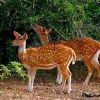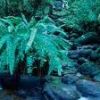සිංහරාජ වනය
Sinharaja Forest Reserve is a national park and a biodiversity hotspot in Sri Lanka. It is of international significance and has been designated a Biosphere Reserve and World Heritage Site by UNESCO.
The hilly virgin rainforest, part of the Sri Lanka lowland rain forests eco region, was saved from the worst of commercial logging by its inaccessibility, and was designated a World Biosphere Reserve in 1978 and a World Heritage Site in 1988. The reserve's name translates as Kingdom of the Lion. It is a treasure trove of endemic species, including trees, insects, amphibians, reptiles, birds and mammals. Because of the dense vegetation, wildlife is not as easily seen as at dry-zone national parks such as Yala. There are about 3 elephants and the 15 or so leopards are rarely seen. The commonest larger mammal is the endemic Purple-faced Languor.
An interesting phenomenon is that birds tend to move in mixed feeding flocks, invariably led by the fearless Greater Racket-tailed Drongo and the noisy Orange-billed Babbler. Of Sri Lanka's 26 endemic birds, the 20 rainforest species all occur here, including the elusive Red-faced Malkoha, Green-billed Coucal and Sri Lanka Blue Magpie. Reptiles include the endemic Green pit viper and Hump-nosed vipers, and there are a large variety of amphibians, especially tree frogs. Invertebrates include the endemic Common Bird wing butterfly and the inevitable leeches.
Peaks; Pinipitigala; Mulawella
Flora
The vegetation of Sinharaja may be described either as a tropical lowland rain forest or tropical wet evergreen forest. Some striking characteristics of the forest are the loftiness of the dominant trees, the straightness of their bole, the abundance of regeneration and the diversity of species. Average height of the trees varies between 35m – 40m.some individuals rise even up to 50m. The vegetation of Sinharaja is that of humid wet evergreen forest type with a high degree of endemism. In fact some families such as Dipterocarpaceae show an endemism more than 90%. The untapped genetic potential of Sinharaja flora is enormous. Out of the 211 woody trees and lianas so far identified within the reserve 139 (66%) are endemic. Similarly, high levels of endemism are perhaps true for the lower plants like ferns, epiphytes as well as out of 25 general endemic to Sri Lanka 13 are represent in Sinharaja. The Total vegetation density, including trees, shrubs, herbs and seedlings has been estimated to be around 240,000 individuals per hectare, of which 95% comprise individuals of the ground layer bellow 1m in height. The density of trees, lianas above 30 cm girth at breast height, ranges between 600 – 700 individuals per hectare while the number of merchantable individuals of trees of girth greater than 150cm ranges between 45-55 individuals per hectare.
Fauna
Studies on the fauna of Sinharaja have revealed that there is a high degree of endemism among the butterflies, fish, amphibians, reptiles, birds and mammals are
Listing Details
Mobile
+94 77 888 5552







